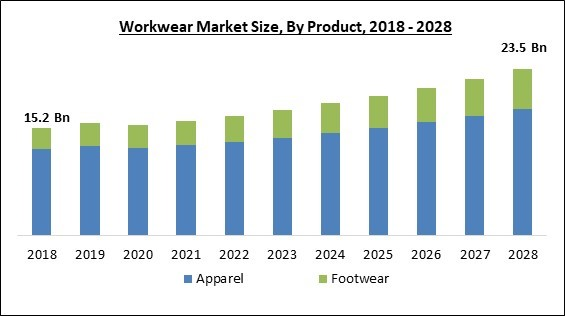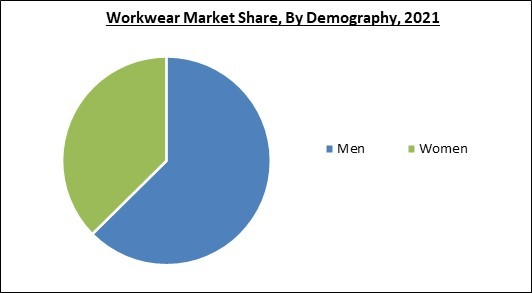The Global Workwear Market size is expected to reach $23.5 billion by 2028, rising at a market growth of 5.7% CAGR during the forecast period.
Workwear is clothing that is worn for work, particularly manual labor. It is frequently chosen by persons employed in trade sectors since it is designed to provide durability and safety. The workplace clothing business is expanding, and consumers have a wide range of options. Men's Workwear continues to grow at a steady rate for chains that have committed to manufacturing large amounts of Workwear and expanding the Workwear market.
If Workwear is given to an employee without a logo, the employee may be subject to income tax as a payment in kind. As well as if company clothing with logos is supplied, the employee may be eligible for a tax credit to assist pay for upkeep.
Good Workwear can assist enhance a company's productivity and production by making employees feel safe and equal, allowing employees to do the jobs more efficiently. Moreover, some jobs necessitate the use of specific equipment and attire in order for employees to feel comfortable while performing important activities in industrial settings. Many businesses are adopting high-visibility Workwear because it simplifies jobs and improves staff recognition.
Workwear is required for everyone working in a professional environment. Small, medium and large businesses all require work clothing for the staff. Even in a school, the teachers are provided with gowns or uniforms. Many organizations and businesses invest in work clothes to improve the atmosphere and ensure the safety of the employees, particularly workers who operate in high-risk industries like construction. Depending on the company's work, different types of workwear are available.
Lack of Enforcement of Strict Safety Standards in Different Nations/h3>Safety rules have different implications in different countries. There are certain government agencies that manage safety standards for numerous industries. This may cause misunderstanding or inconsistency in the industrial workwear industry when it comes to monitoring overall worker safety, which might have a negative impact on the industrial workwear market's growth prospects. Despite legislative systems, similar safety situations do not exist in other regions. Several agencies, for example, do not follow normal processes and safety standards, which leads to a rise in the incidences of fatalities.
The market research report covers the analysis of key stake holders of the market. Key companies profiled in the report include Honeywell International, Inc., Kimberly-Clark Corporation, 3M Company, Aramark Corporation, Alsico Group, Alexandra (Mi Hub Limited), A. LAFONT SAS, Aditya Birla Fashion and Retail Limited (Aditya Birla Group), Ansell Ltd., Carhartt Inc.
By Product
Workwear is clothing that is worn for work, particularly manual labor. It is frequently chosen by persons employed in trade sectors since it is designed to provide durability and safety. The workplace clothing business is expanding, and consumers have a wide range of options. Men's Workwear continues to grow at a steady rate for chains that have committed to manufacturing large amounts of Workwear and expanding the Workwear market.
If Workwear is given to an employee without a logo, the employee may be subject to income tax as a payment in kind. As well as if company clothing with logos is supplied, the employee may be eligible for a tax credit to assist pay for upkeep.
Good Workwear can assist enhance a company's productivity and production by making employees feel safe and equal, allowing employees to do the jobs more efficiently. Moreover, some jobs necessitate the use of specific equipment and attire in order for employees to feel comfortable while performing important activities in industrial settings. Many businesses are adopting high-visibility Workwear because it simplifies jobs and improves staff recognition.
Workwear is required for everyone working in a professional environment. Small, medium and large businesses all require work clothing for the staff. Even in a school, the teachers are provided with gowns or uniforms. Many organizations and businesses invest in work clothes to improve the atmosphere and ensure the safety of the employees, particularly workers who operate in high-risk industries like construction. Depending on the company's work, different types of workwear are available.
COVID-19 Impact Analysis
COVID-19 has impacted a wide range of industries, comprising safety and industrial clothing. Governments all across the world have implemented strict restrictions prohibiting the closure of manufacturing plants, supply chains, retail stores, and a variety of other enterprises that require workwear, with the exception of critical services. On the other side, the pandemic has had a good impact on the medical and healthcare industry, prompting an increase in workflow and generating a lot of demand for surgical and medical clothing from biological facilities. As a result of the unprecedented demand for such clothing, leading Personal Protective Equipment (PPE) manufacturers increased the production capacity in order to satisfy the rising demand. Design, production, manufacture, distribution, consumption, and disposal of raw materials, clothes, textiles, accessories, and footwear all have an impact on the industrial workwear businessMarket Growth Factors
Increasing Need for Secure and Durable Workwear Leading to Industrialization 2.0
High-quality Workwear offers a sense of security to the industrial workers. Owing to the accessibility of low-cost Labour and raw materials has enabled several corporations from different regions to construct operations in emerging economies across a variety of industries. As an outcome of the implementation of safety requirements, the developing automotive industry, chemical industry, oil & gas industry, and other industries throughout the world choose protective apparel, which is increasing the need for industrial Workwear. E-sites have aided in gaining momentum in the market by allowing enterprises to expand their footprint throughout geographies while also allowing new players to emerge.More Standardization Imposed by the Government in Industries for Workers
Government bodies of various regions are increasingly focused on providing uniformity and safety to a worker employed in high-risk workplaces like heavy steel, chemical, textiles, ceramics, etc. Such government entities are issuing and implementing relevant rules and regulations along with a proper code of conduct which will vary as per the conditions present in a specific industry. To ensure the implementation of standards within the industries, regional governments are making regular checks. Also, a dedicated supervisor is appointed in these high-risk workplaces to make sure the safety and ease of workers in the workplace.Market Restraining Factors
Lack of Enforcement of Strict Safety Standards in Different Nations/h3>Safety rules have different implications in different countries. There are certain government agencies that manage safety standards for numerous industries. This may cause misunderstanding or inconsistency in the industrial workwear industry when it comes to monitoring overall worker safety, which might have a negative impact on the industrial workwear market's growth prospects. Despite legislative systems, similar safety situations do not exist in other regions. Several agencies, for example, do not follow normal processes and safety standards, which leads to a rise in the incidences of fatalities.
Product Outlook
Based on the Product, the workwear market is divided into Apparel and Footwear. The Apparel segment witnessed the maximum revenue share in the workwear market in 2021. Apparel is important in the various workplace because it provides a sense of uniformity among the co-workers, enhances the working environment, and sense of security for workers who operate in a workplace with a significant amount of injury risk. These apparel gives employees a boost of confidence which ultimately benefit the organization’s objective.
Demography Outlook
Based on Demography, the workwear market is bifurcated into Men and Women. The Women segment garnered a significant revenue share in the workwear market in 2021. Gender discrimination against hard work is declining, which is enabling women to take up more challenging jobs. As a result, the market for women's demography is predicted to increase significantly throughout the forecast period.
Application Outlook
Based on Application, the workwear market is classified into Chemical, Power, Food & Beverage, Biological, and Others. The Chemical segment witnessed the maximum revenue share in the workwear market in 2021. The chemical industry's rapid expansion can be attributed to the industry's strict safety regulations. The majority of companies in the chemical business are concerned about their safety measures, which will drive up demand in the coming years. Companies are raising awareness among the employees about the negative consequences of dangerous chemicals, which is encouraging employees to wear workplace clothes and footwear.
Regional Outlook
Based on Region, the workwear market is analyzed in Asia Pacific, North America, Europe, and LAMEA. Asia Pacific emerged as the leading region in the workwear market with the largest revenue share in 2021. The APAC regional expansion can be ascribed to the region’s growing job possibilities, which are predicted to increase the demand for workwear clothing among the working population. Moreover, the region's rapid growth of the e-commerce business has enhanced the availability of a wide range of workwear items.The market research report covers the analysis of key stake holders of the market. Key companies profiled in the report include Honeywell International, Inc., Kimberly-Clark Corporation, 3M Company, Aramark Corporation, Alsico Group, Alexandra (Mi Hub Limited), A. LAFONT SAS, Aditya Birla Fashion and Retail Limited (Aditya Birla Group), Ansell Ltd., Carhartt Inc.
Scope of the Study
Market Segments Covered in the Report:
By Product
- Apparel
- Footwear
- Men
- Women
- Chemical
- Power
- Food & Beverage
- Biological
- Others
- North America
- US
- Canada
- Mexico
- Rest of North America
- Europe
- Germany
- UK
- France
- Russia
- Spain
- Italy
- Rest of Europe
- Asia Pacific
- China
- Japan
- India
- South Korea
- Singapore
- Malaysia
- Rest of Asia Pacific
- LAMEA
- Brazil
- Argentina
- UAE
- Saudi Arabia
- South Africa
- Nigeria
- Rest of LAMEA
Key Market Players
List of Companies Profiled in the Report:
- Honeywell International, Inc.
- Kimberly-Clark Corporation
- 3M Company
- Aramark Corporation
- Alsico Group
- Alexandra (Mi Hub Limited)
- LAFONT SAS
- Aditya Birla Fashion and Retail Limited (Aditya Birla Group)
- Ansell Ltd.
- Carhartt Inc.
Unique Offerings from the Publisher
- Exhaustive coverage
- The highest number of Market tables and figures
- Subscription-based model available
- Guaranteed best price
- Assured post sales research support with 10% customization free
Table of Contents
Chapter 1. Market Scope & Methodology
Chapter 2. Market Overview
Chapter 3. Global Workwear Market by Product
Chapter 4. Global Workwear Market by Demography
Chapter 5. Global Workwear Market by Application
Chapter 6. Global Workwear Market by Region
Chapter 7. Company Profiles
Companies Mentioned
- Honeywell International, Inc.
- Kimberly-Clark Corporation
- 3M Company
- Aramark Corporation
- Alsico Group
- Alexandra (Mi Hub Limited)
- A. LAFONT SAS
- Aditya Birla Fashion and Retail Limited (Aditya Birla Group)
- Ansell Ltd.
- Carhartt Inc.










